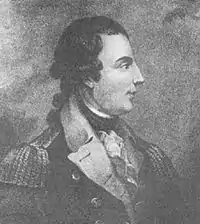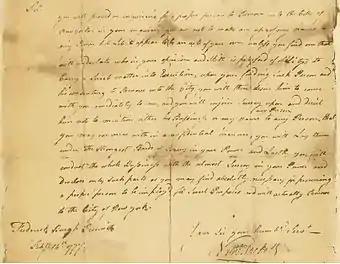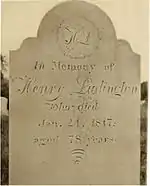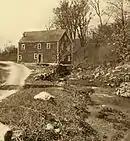Henry Ludington
Henry Ludington (May 25, 1739 – January 24, 1817) was an American businessman who ran a grist mill and owned a substantial parcel of land in New York state. He founded Ludingtonville, which later became the town of Kent, New York. He lived in Patterson, New York, for four decades and was involved with its growth.
Henry Ludington | |
|---|---|
 Henry Ludington sketch, circa 1800 | |
| Born | May 25, 1739 |
| Died | January 24, 1817 (aged 77) |
| Nationality | American |
| Occupation | Businessman, patriot, Colonel |
| Known for | Role in American Revolution |
| Signature | |
Ludington fought in the Seven Years' War and, as captain, commanded a volunteer regiment at the Battle of Ridgefield during the American Revolutionary War. Ludington was promoted to colonel and became an aide-de-camp to General George Washington by providing spies. He was associated with John Jay in a ring of spies. Sybil Ludington, his daughter, helped the cause for independence by undertaking a nighttime horseback ride similar to Paul Revere's to alert colonial militia to the approach of British forces.
Other members of the Ludington family became prominent in states including Wisconsin and Michigan. Some became leaders while others were involved in developing towns.
Ancestry
Ludington's great-great-grandfather William Ludington (b. 1608) and his wife Ellen (b. 1617) were of English origin. They were married in England in 1636. A few years later they immigrated to America. William and Ellen moved permanently to Charlestown, Massachusetts, in 1640 and raised seven children (one had been born in England).[1] William and his wife established the Ludington family in America and many of their descendants live in the Eastern United States.[2] William and Ellen moved to New Haven, Connecticut, about 1660.[3] It is recorded by 20th-century historian Louis S. Patrick that William died in 1663 at East Haven.[4] By other historians his death is recorded as occurring in 1662.[5] The difference in dating is due to the use the Julian Calendar in the mid-18th century in the Thirteen Colonies in America.[6]
The sixth child of William senior, the founder of the American Ludingtons, was another William Ludington (second in the family) who was born about 1655 (died 1737). His first wife was Martha Rose and they had two sons and a daughter. Their first child was a Henry Ludington, who was born in 1679. The second child of this Henry Ludington was another William Ludington, born in Branford, Connecticut, on September 6, 1702. He married Mary Knowles November 5, 1730, and they had eight children. Their third child was named Henry Ludington.[7]
Life
Ludington was born on May 25, 1739, in Branford, Connecticut.[8][9] He had two older sisters, Submit and Mary, and five younger siblings, Lydia, Samuel, Rebecca, Anne, and Stephen. Not all survived to adulthood.[10] Ludington was schooled as a child in Branford and received education typical to that taught in colonial towns of the 18th century.[9] The school was controlled by the local Christian church and provided a basic education. He was not interested in scholarly studies, but thought in terms of action instead and decided to discover the world. He ventured out on his own and never completed his schooling.[11] He was influenced by the activities he came across of the French and Indian War, which was a part of the Seven Years' War.[12]
Ludington enlisted in the local military in September 1755, at the age of sixteen. He was with Captain Foote's company of the Second Connecticut Regiment.[13] Historian Louis S. Patrick says that Ludington re-enlisted on April 19, 1756, served under Colonel Andrew Ward at Crown Point, and was discharged on November 13, 1756. He was called back again for fifteen days of service at a "general alarm" for the relief of Fort William Henry in August 1757. He re-enlisted on April 14, 1759, for the campaign of the Second Connecticut Regiment under Colonel Nathan Whiting and was a member of David Baldwin's Third Company.[14]
Ludington marched with the British and American troops to Canada and participated in the Battle of Quebec on September 13, 1759. At the age of twenty he was placed in charge of a company of sixty wounded soldiers who returned to New England. The journey from Quebec to Boston was made in the severe winter of 1759–1760. Even though there were many hardships like running out of provisions and having to sleep in caves of snowdrifts Ludington got his disabled comrades home safely. He then proceeded from Boston to Branford, Connecticut, in the spring of 1760 and retired from the military. He returned to civilian life and married his cousin Abigail on May 1, 1760. She was born on May 8, 1745, and was turning fifteen years old. They had twelve children, all born in Kent, New York (then known as Fredericksburgh).[15]
Ludington received from King George II the promotion to lieutenant in the British Colonial Army in recognition of his services. He held that position until the passage of the Duties in American Colonies Stamp Act in 1765, when he resigned in protest.[16] Ludington then accepted on February 13, 1773, a captain's commission from William Tryon, the last British governor of New York. He held that position until the beginning of the American Revolution. Ludington then was the American commander of the 7th regiment (infantry) of "Dutchess County" in New York in the Battle of Ridgefield in April 1777, of the American Revolutionary War.[17] The volunteers were mostly from the towns of Kent and Carmel of the county (later Putman County).[18] His uncles were patriots and fought in one way or another for American independence.[19]

Ludington was affiliated with George Washington as an aide-de-camp.[20][21] He worked with Washington and helped establish the initial "secret service" in America.[8][9][20][22] Washington, in his campaign for American independence, came up with the idea that if he knew ahead of time the British plans he could prepare to guard against them in a defense. He gathered together patriots in a secret service of espionage to gather information on British troops and their activities. This gave him a strategical advantage in his military movements.[8][23] He sent a letter on February 4, 1777, to the military commander Nathaniel Sackett for assistance on this.[24] Sackett in turn sent a letter ten days later to Ludington asking for help to furnish spies in Dutchess and Westchester Counties, New York, to gather information on British activities.[8][25]

To Colonel Henry Ludington Esqr.
Sir,
you will proceed on inquiring for a proper person to Remove into the City of New York. in your inquiry you are not to make any use of my name to any Person, but let it appear to be an act of your own unless you find one that in your opinion and skill is possessed of abilitys [sic] to carry a secret matter into Execution. upon your finding such a Person and his consenting to Remove into the city you will then desire him to come with you immediately to me, and you will enjoin secrecy upon and direct him not to mention either his business or my name to any Person. any Person that you may converse with in a confidential manner, you will Lay them under the strongest Bonds of secrecy in your Power. and lastly you will conduct the whole Business with the utmost secrecy in your Power and disclose only such parts as you may find absolutely necessary for procuring a proper Person to be employed for Secret Purposes and will actually Remove to the City of New York.
I am Sir your humble Servt,
Nathl. Sackett
Frederick Burgh Precinct,
Feby 14th, 1777
Among the first spies Ludington collaborated with was Enoch Crosby.[26] Crosby was an American Revolutionary War soldier and worked in the territory where Ludington commanded troops. A shoemaker by trade, while traveling for his trade Crosby was able to obtained critical information of British activity from locals that was of key important to Washington for his strategies.[27] Ludington knew that Crosby had this information and his objective to get it to American patriots so aided him by providing shelter and necessary provisions for his activities. He also helped other spies, among them Benajah Tubbs.[26] Ludington gathered information vital to Washington and passed it on to the Continental Army. He worked with John Jay in a spy ring that gathered information about British activities.[27]

Ludington was much involved in the community of Patterson, New York. He built the "Luddington Mill" during the struggle for American independence and gave the lumber required for building the first local academy, an important school for the town.[20] He was one of the trustees of the Presbyterian church and in 1793 helped purchase land for its cemetery.[28]
Ludington was sociable and often in his retirement met with John Jay and John Crane at Elijah Townsend's house to talk about what they did as spies of the American Revolution. He died of cancer at the age of 78 on January 24, 1817. His remains were buried in the churchyard of the town's Presbyterian church. The Patterson grave is marked with a tombstone that has a short inscription:[29]
H. L.
In Memory of
Henry Ludington
Jan. 24, 1817
Aged 78 years
Historian William J. Blake of Putnam County said the epitaph didn't do justice for the patriot that helped develop the American government. Ludington's wife, Abigail, died eight years later at the age of 80 on August 3, 1825, and is buried beside him.[28]

Ludington instructed the executors of his estate to sell off a part of his farm to pay for debts he owed. The remaining part of his farm was to go to his wife, daughter, son and granddaughter. The will said that if any of them married, they would relinquish their portion of the estate and it would go to the benefit of those unmarried.[30] The grist mill that Ludington built around 1775 and the immediate area is known as the hamlet of Ludingtonville.[9][31] The grist mill contained the local post office.[32] The mill was part of Ludington's Will.[30] This area is now in the town of Kent which is near Carmel, New York.[32]
Ludington was the grandfather of Harrison Ludington, who was the mayor of Milwaukee in 1871, 1873, and 1875 – also the 12th governor of Wisconsin.[33] His daughter, Sybil Ludington, is known as the female Paul Revere for her role in alerting her father's Minute Men troops to meet the advancing British army.[21][34][35] Ludington's grandson, James, founded Ludington, Michigan. The Ludington legacy has been handed down to several other states in the founding of other towns from his descendants.[36]
References
- Johnson 1907, p. 18.
- Johnson 1907, p. 19.
- Johnson 1907, p. 9.
- Patrick 1907, p. 15.
- Pelletreau 1886, p. 691.
- Johnson 1907, p. 10.
- Johnson 1907, p. 22.
- Patrick 1907, p. 265.
- Miller 1907, pp. 504–508.
- Johnson 1907, pp. 22–23.
- Johnson 1907, pp. 24–25.
- Johnson 1907, p. 25.
- Johnson 1907, pp. 26–27.
- Johnson 1907, p. 29-30.
- Johnson 1907, pp. 35–45.
- Johnson 1907, pp. 30–31.
- NYGBS 1989, p. 226.
- Pierce 1901, p. 270.
- Johnson 1907, pp. 20–21.
- "Secret Service of the American Revolution". Connecticut (CT) Sons of the American Revolution. 2017. Retrieved April 24, 2017.
This is a true story of what might be termed the "secret service." It relates the life of a man of whom little is recorded but whose services to his country were such that justice should be done his character. Colonel Henry Ludington
- National Magazine 1893, p. 479.
- Stevens, Maryanne (April 23, 1975). "Ludington History Live in Oak Park". News Journal-page 13. Chicago, Illinois – via newspapers.com
 .
. Ludington was also in charge of the American secret service in New York, choosing the men, directing them and often hiding them in his house.
- Rose, P.K. (2007). "The Founding Fathers of American Intelligence". Library. Central Intelligence Agency. Retrieved April 25, 2017.
- "George Washington orders to Nathaniel Sackett, 4 February 1777". Retrieved April 25, 2017.
- Johnson 1907, pp. 114–116.
- Johnson 1907, pp. 115.
- Patrick 1907, p. 270.
- Johnson 1907, pp. 208–209.
- "Ludington Graves - Patterson, NY". Waymarking.com. Waymarking. 2020. Retrieved October 6, 2020.
- Johnson 1907, pp. 210–211.
- US Congress 1963, p. 3168.
- Johnson 1907, p. v.
- White 1904, p. 78.
- Frank 2013, p. 365.
- Hotchkiss 1898, p. 306.
- Johnson 1907, pp. 228–229.
Sources
- Frank, Lisa Tendrich (2013). American Women at War. ABC-CLIO. ISBN 978-1-59884-443-6.
- Hotchkiss, George Woodward (1898). Forest Industry of the Northwest. G.W. Hotchkiss & Company. OCLC 6829978.
- Johnson, Willis Fletcher (1907). Colonel Henry Ludington. L.E. and C.H. Ludington (original from Harvard University). ISBN 9783337681623.
- Miller, Francis Trevelyan (1907). Journal of American History. American Records. OCLC 24088243.
- National Magazine (1893). The National Magazine. Magazine of Western History Publishing Company. OCLC 935053355.
- NYGBS (1989). New York Genealogical. New York Genealogical Society. OCLC 794289348.
- Patrick, Louis S. (1907). The Connecticut Magazine. Connecticut Magazine Company. OCLC 17941131.
- Pelletreau, William Smith (1886). Putnam County, New York. W.W. Preston. p. 691. OCLC 829938001.
- Pierce, Frederick Clifton (1901). Field Genealogy. W.B. Conkey Company. p. 270. OCLC 1179179920.
7th Regt Dutchess County New York Col. Henry Ludington.
- US Congress (1963). Congressional Record. U.S. Government Printing Office.
- White, J.T. (1904). National Cyclopaedia of Biography. OCLC 936240315.
External links
| Wikimedia Commons has media related to Henry Ludington. |